#micro animal
Explore tagged Tumblr posts
Text
Wet Beast Wednesday: tardigrades
Last week on Wet Beast Wednesday I covered the largest animals to ever exist on our planet. This week I'm going to pull a full 180 and cover the smallest animals yet on this series. Meet the tardigrade, the internet's favorite micro-animal the is said to be basically immortal. How true is that? Let's see.
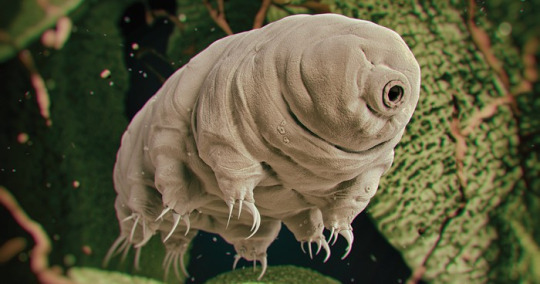
(Image: an electron microscope image of a tardigrade. It looks a lot like a potato with eight stubby legs tipped with long claws. At the front is a small, circular mouth. It has no other discernable features. In the background are bits of plant matter that look like seaweed at this scale. End ID)
The tardigrades are 1,300 known species (and probably a lot of unknown ones too) in the phylum Tardigrada. They are also part of the superphylum Ecdysozoa, which are animals that grow by molting their outer cuticles or exoskeletons. In particular, the tardigrades are believed to be a sister group of the arthropods, the group that contains crustaceans, insects, isopods, and a lot of other things. Tardigrades are truly tiny, the largest species reaching a whopping 1.5 millimeters in length, though most species reach no more than 0.5 mm. They have round, segmented bodies with four pairs of legs that end in either claws or suction discs. The body segments consist of a head, three body segments with a pair of legs each, and a caudal segment with the final pair of legs. The first three legs are used for movement while the final pair points backwards and is used for grabbing onto substrate. All of the body segments except for the final one correspond to segments found in the head section of insects. Tardigrades are missing many hox genes, genes that direct the body plan during development. Their ancestors may have had a body plan more similar to insects, but the loss of the hox genes has compressed them into walking heads with a bit of butt. The mouth is tubular and sucks in food. In the mouth are stylets, needle-like structures used to pierce food objects. Once food is drawn into the mouth, a structure called the buccopharyngeal apparatus activates. This is a combination of spines and muscle that acts like an inner jaw that pulls food into the digestive tract. The buccopharyngeal apparatus is distinct enough to be used as a major identifying feature between species. Tardigrades are translucent and many images you've seen of them have false color to show the details or are 3D models based on scanning electron microscope imagery of them. Tardigrades molt their exoskeletons multiple times (up to 12) during their lifecycle. Some species are unable to poop normally and instead all their waste is discarded during the molt. It was formerly believed that tardigrades could exchange genes with each other without mating, a process called horizontal gene transfer that is seen in bacteria, archaea, and other micro-organisms. It has since been discovered that while still capable of horizontal gene transfer, it is quite a bit rarer in tardigrades than we thought.
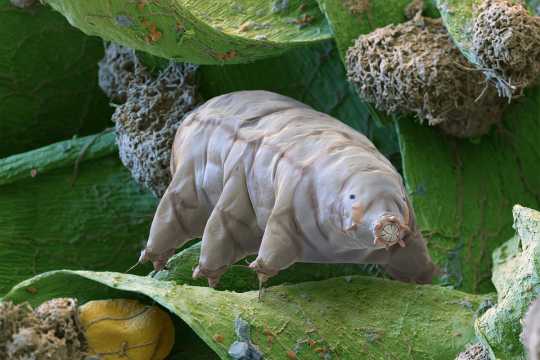
(Image: an electron microscope image of a tardigrade standing on a bit of plant matter. This one has a closed mouth with a ring of triangular tooth-like structures. It also has two simple eyes that look like black dots. End ID)
The name "tardigrade" means "slow walker", which is fitting as, despite their eight legs, tardigrades have a slow and awkward gait. This is the result of their legs being unjointed, only able to pivot at their connection to the body. Their gait has been compared to that of bears, hence why they are often called water bears and their discoverer, Johann August Ephraim Goeze, called them "kleiner wasserbär", meaning "little water bear". Tardigrades are found worldwide and have inhabited virtually every habitat, from the tops of mountains to the deep sea, from hot springs to the antarctic, from freshwater to saltwater. The one thing they have in common is a need to stay wet. Tardigrades can survive out of water as long as they can stay moist and are often found in mosses, hence another common name: moss piglets. The majority either eat plants or bacteria, but some will feed on smaller tardigrades or other micro-animals. Their famous survivability makes it easy for tardigrades or their eggs to be carried to new habitats by larger animals or other phenomena. Tardigrades are one of the first micro-animals to colonize a new habitat and they are a pioneer species, the first species to colonize a new environment and whose presence makes that environment fore suitable for other species to follow. Tardigrades are a major food source to other micro-animals and larger organisms. Most species have distinct males and females, though a few reproduce through parthenogenesis. In most cases, molting female will lay her eggs in her shed cuticle and males will them fertilize them. Other species have a form of internal reproduction. Males and females will court each other before mating and females will usually allow multiple males to fertilize her eggs. Female tardigrades are typically larger and more abundant than males. Eggs can take up to 14 days (species dependent) before hatching. All tardigrades of the same species have the exact same number of cells as each other. They are also born with the same number of cells they will have as an adult. Their growth is driven by enlargement of the existing cells rather than cellular reproduction making new cells. The lifespan ranges between a few months to a few years, depending on species.
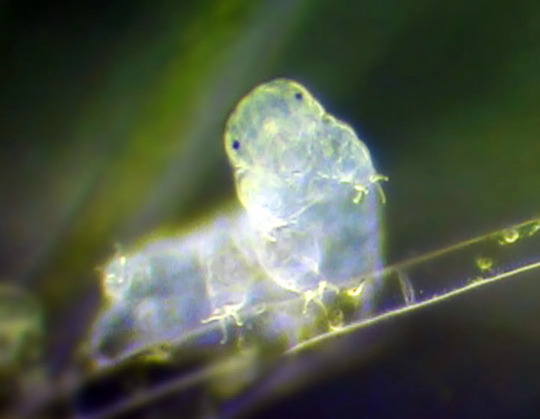
(Image: a color photo of a tardigrade. It is a pale, translucent white, making it hard to make out details. Its body is curved, with the front end pointing at the camera. It has two simple eyes. End ID)
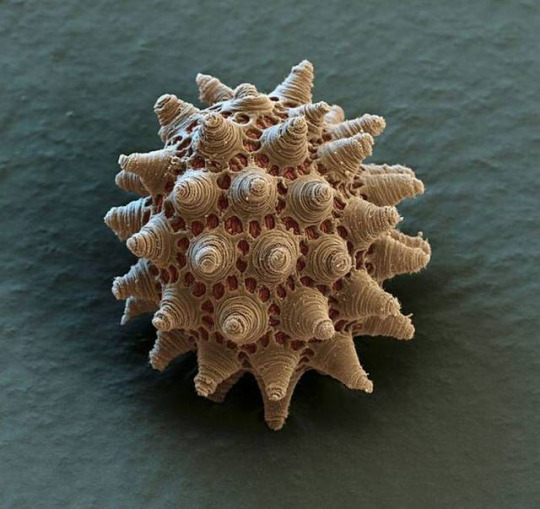
(Image: an electron microscope image of a tardigrade egg. It is round but covered in small pores and conical structures. End ID)
The most famous feature of tardigrades is their legendary durability. It is commonly said that tardigrades can survive just about anything (except for the things that are actually trying to kill them. They are prey to a lot of species after all). Among the things they can survive is extreme heat, extreme cold, dehydration, extremely high and low pressure, exposure to ionizing radiation (that's the scary kind), low oxygen environments, environmental toxins, heavy impacts, and the vacuum of fucking space. While the can survive in extreme conditions, tardigrades are not considered extremophiles. True extremophiles thrive in extreme environments and are negatively impacted by leaving them. Tardigrades can survive in extreme environments, but are negatively impacted and can't survive as well there as they can in less extreme places. The main trait that has allowed tardigrades to survive all five mass extinctions in history is cryptobiosis. Cryptobiosis is the rare ability for an animal to enter a state of dormancy where their metabolic processes come to an almost complete stop. While in cryptobiosis, metabolic activity drops to 0.01% normal and water content drops to 1% normal. In this state, the tardigrade is called a tun. Tardigrades usually enter cryptobiosis in response to arid conditions. One experiment showed that a species of tardigrade could last for at least 30 years in this state and return to normal lifestyle functions when exposed to water. Tardigrades will also enter cryptobiosis in response to low oxygen, toxic chemical exposure, increased or decreased temperature, and excessive salt content in the water. Tardigrades also show extreme resistance to both high and low pressure. They can live in 0 atmospheres of pressure and some species can survive up to 6,000 atmospheres, more than double the pressure at the bottom of the Marianas trench. More interesting is their ability to survive dangerous radiation. They can survive 1,000 times the dose of gamma radiation that humans can. Early tests focused on tardigrades in cryptobiosis and concluded that the extremely low water content of a cryptobiotic tardigrade doesn't leave much opportunity for the radiation to react with the animal. However it was later found that active and fully hydrated tardigrades are still considerably resistant to radiation. Studies into this resistance indicate that tardigrades can very efficiently repair damaged DNA and have unique proteins called Dsup that provides additional protection. Dsup introduced to human cells has provided additional protection against x-rays.
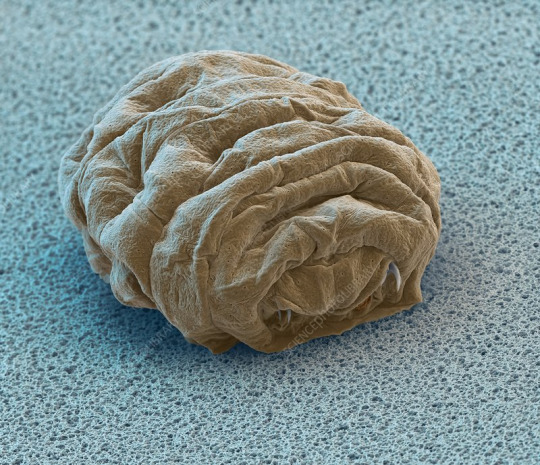
(Image: an electron microscope image of a tun - a tardigrade in cryptobiosis. It is smaller and very wrinkly, with the legs and mouth retracted into the body. End ID)
Tardigrades were the first animals to be exposed to the vacuum of space. They were exposed for 10 days, some in a state of cryptobiosis at the time of exposure and some still active. It was found that they were able to survive the vacuum when shielded from the sun's ultraviolet radiation, with those already in cryptobiosis doing better. Upon being rehydrated, many were able to resume normal life functions and successfully reproduce, though others died after being rehydrated. Those that were exposed to UV radiation fared much worse, with only a few hydrated individuals surviving. The individuals in cryptobiosis had a lower survival rate when exposed to UV than those not exposed to UV and were less successful at reproducing afterwards. Studies of tardigrade's space survival abilities and resistance to radiation could go a long way in helping human space travel. One of the largest dangers of space travel is that space is full of nasty radiation from the sun that Earth's magnetic field protects us from. Some scientists speculate about the possibility of accidentally seeding other planets or moons with tardigrades or other space-resistant organisms. This is a problem because introducing Earth life to other world has the potential to damage any native ecosystems and if we find life in space in the future we don't want to have to figure out if it's something we accidentally put there. While tardigrades could likely survive on other planets, they would eventually die without a food source. Some sources reported that tardigrades may have colonized the moon after an experiment with them crashed. Unfortunately, the moon is not crawling with tardigrades now. It's way too dry for them to exit cryptobiosis even if they survived the crash, which they probably didn't.

(Image: art of a tardigrade floating in the vacuum of space. End ID. Source: University of California - Santa Barbara)
#wet beast wednesday#tardigrade#water bear#moss piglet#micro animal#microbiology#marine biology#biology#zoology#ecology#animal facts#informative#science#space#astrobiology#radiation#cryptobiosis#tun#image described
199 notes
·
View notes
Text
As someone who loves animated tv and movies I can say with certainty that the way arcane uses micro expression is so special.
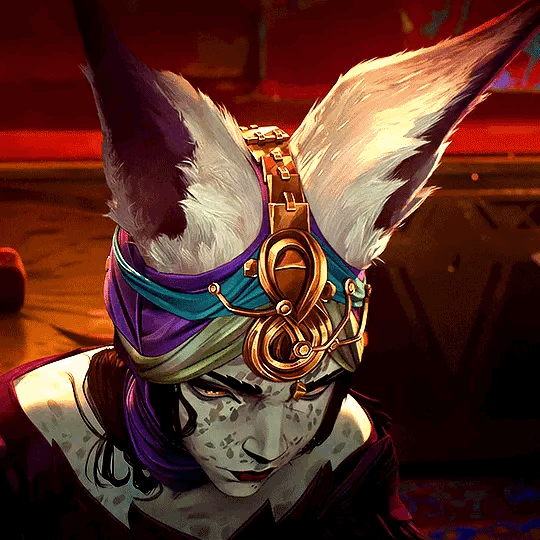

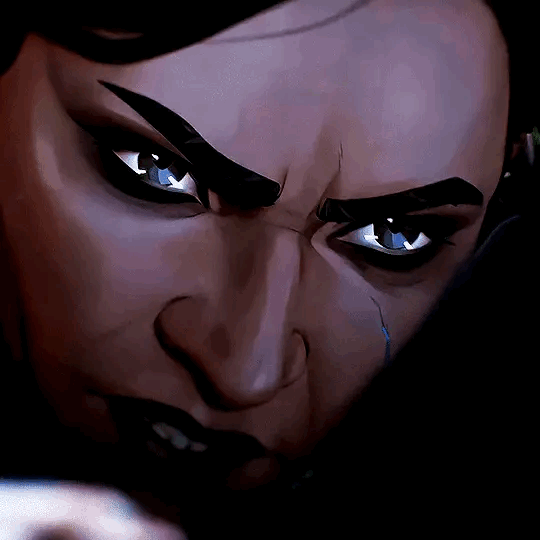
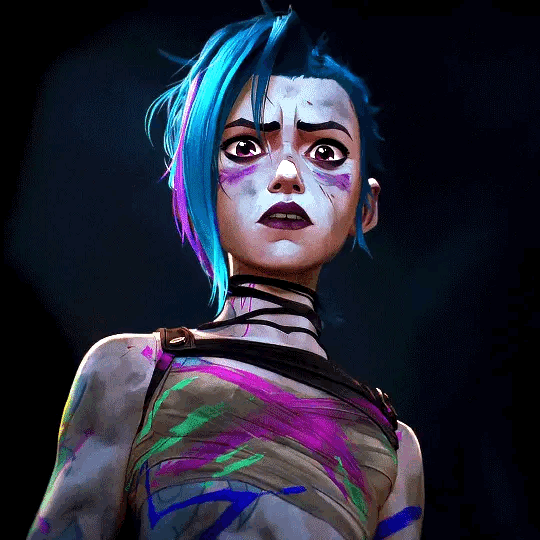
The animation of expressions is simplified in most media for obvious reasons but when arcane animates expression they seem to actually take advantage of the ability to animate each frame to really detail these micro expressions.
They add so much depth to the characters and the story in my opinion. Allowing for the audience to see the conflicting and underlying thoughts and emotions behind a characters actions.
Movement in the ears, eyebrows, lips, jaw, flickering of the eyes or eyelids. Even the way a movement can be faster or slower, halting or assured. All of it tells the story of what the character is going through or thinking better than words can.
This is why I don’t really think much about the arguments that revolve around “they never explicitly talked about this, or apologized, or gave forgiveness etc” cause it’s the little things arcane shows visually like these micro expressions which paint a much more complex picture that doesn’t need words to communicate.


#all gifs are from arcanegif#there’s so many more amazing ones of the micro expressions I could watch all day#arcane#animation#arcane animation#caitvi#artistic expression#character design#character art#character study#vi#jayce arcane#jayce talis#ekko arcane#jinx arcane#timebomb#lest arcane#savika arcane#jinx#mine#thoughts
2K notes
·
View notes
Text
Manifestation Time!
I will be bigger I will be fatter I will be bigger I will be fatter.
I will get stuck in doorways I will get stuck in doorways.
I will be stuffed full I will be stuffed full I will be stuffed full.
⭐️🍔⭐️🍫⭐️🍟⭐️🍕⭐️🍔⭐️🍫⭐️🍟⭐️🍕⭐️🍔

#inflated belly#fat anime#fat belly#fat piggy#feedee belly#micro blob#fatfur#fatfurry#stuffed fatty#inflateme
2K notes
·
View notes
Text

#sandylion#90s#fuzzy#animals#sticker sheet#fuzzy animals#agere space#agere little#little space#Fuzzy#1990s#micro#The whole gang#favorite
359 notes
·
View notes
Text
Gayboy Micro

#Dwarf Little fruit bat#Bats of South America#bat of the day#daily bat#bat#bats#batposting#cute bats#Cute animals#Micro#gayboy#I love them lmao
176 notes
·
View notes
Text
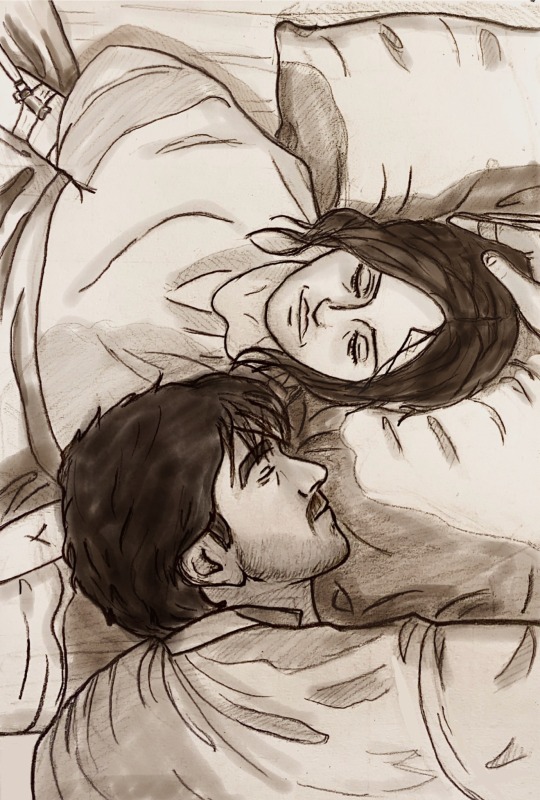
The best medicine ❤️🩹
…and a small gif-addition

258 notes
·
View notes
Text
Every once in a while I will see a post claiming vegans kill more animals then people who eat meat because of the rodents and birds killed harvesting crops and it always makes me laugh.
If you don’t want to be vegan then don’t be vegan but if you’re going to be a troll, at least use your brain.
You also eat fruit, vegetables, nuts, legumes and grains. (Not just vegans.)
You know who else also eats those? Livestock.
Almost 80% of the world’s soybean crops are fed to livestock. A quick google search will prove this to you.
#vegan#veganism#govegan#go vegan#veganfood#vegan food#animals#farm#farms#factory farms#animal rights#animal liberation#animal welfare#Alf#animal liberation front#vegetarian#what vegans eat#whatveganseat#vegan girl#vegangirl#cute animals#animal lover#baby animals#cows#cow#pig#pigs#micro pig#chickens#cottage core
305 notes
·
View notes
Text
studio obake
make the micro music and short animation.
studioOBAKE https://studio-obake.com/
#ghost#short animation#micro music#chillout#lo-fi animation#lo-fi music#original character#character#obake#studio obake#cute#kindness#おばけ#かわいい#やさしい
697 notes
·
View notes
Text
just been daydreaming about a world where tinies are the primary actors in modern day to create lower budget films
-cheaper transportation from filming location to filming location
-less costs for props and background creation/setup
-cheaper costs for costuming fabrics resulting in much higher quality and more extravagant costumes
-think of the adorable lunches the big producers/camera folk set up for them. huge feasts of fruit and pastries that are specially cubed for easier munching from the tiny crew
TINY ACTORS AND ACTRESSES AHHHHH
#feel free to take this idea and run w it#i keep imagining the setup of stop motion animation films but TINY FOLK#EEEEE#g/t#giant/tiny#macrophilia#macro/micro
86 notes
·
View notes
Text
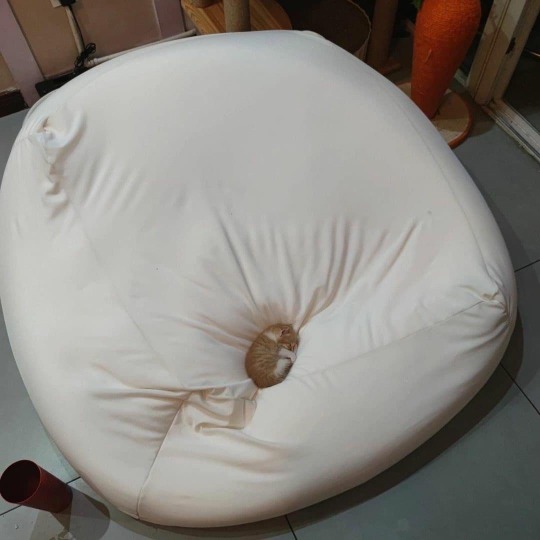
#launch it into orbit#memes#cat memes#meme#funny#funny memes#cute#cute animals#cat#wholesome#cats#animals#micro#smol#cute kitty#kittens#kitten#small#funny animals#tiny
985 notes
·
View notes
Text
kinktober day eighteen
tfa sentinel x reader
tws/content- toys, public (office), finger biting, masturbation, sounding
Sentinel gasps when the vibrator’s intensity increases and decreases in the blink of an optic. He scowls when he hears a ping on his datapad from you.
Y/n: Thinking of you <3
He frowns, pressing his thighs together. He'll get you back. The intensity of the vibrations fluctuates again, forcing him to bite his lip and throw his helm back.
"Dammit..." he sighs, taking a glance at the door to see if it was locked, it is. He lets his interface panels slide away, exposing his warm and wet array to the cold office air. Should he really do this? Run the risk of getting caught or disappointing you? He sighs, shakily putting his digits against his valve mesh, making slow, circular motions.
Y/n: Primus, you're probably already touching your valve, dripping and weeping from your spike just thinking about me touching you.
Damn it, he hates when you're right.
How can he not get transfluid all over his office? The last time he had to clean up after himself right after overload, he couldn't really enjoy it... Sentinel looks up at his desk, blue optics landing on a thinner writing utensil. Almost perfect. But good enough.
He grabs the utensil, swiping it over his tongue before putting the tip against the slit of his spike.
"Frag..." he gasps, pushing the blunt side of the utensil into his spike. Sentinel winces, baring his denta at the soon-to-be pleasurable stretch. He pushes it deeper, making sure it wouldn't dip inside of his spike, keeping a small amount of pressure at the end of the writing utensil so it won't slip out. He whines, trying not to look at the sight of his own array. It already feels like he's on the edge, Sentinel tosses his helm back and lets his intake open. The prime wraps a servo around his spike, squeezing it gently and feeling the unusual, but enjoyable sensation of the intrusion. "Ngh..."
The blue bot gives his spike a gentle pump, gasping, pulling the writing utensil along with his servo. The bio lights along his spike flash and pulse erratically. He whines and sighs exasperatedly, gingerly stroking up and down his spike, feeling the hotness in his core stir jarringly. Sentinel bites his derma, trying not to make any louder noises. Why the hell couldn't he just wait to come back home and frag you, like a normal bot would do?
The feeling flares up in his core again, he tenses in his office chair. He instinctively shoves two digits into his intake, thighs shaking in anticipation and pleasure.
This is going to be such a long day...
#valveplug#micro’s kinktober#kinktober#kinktober 2023#tfa#tfa x reader#transformers animated#transformers animated x reader#sentinel#tfa sentinel#sentinel prime#tfa sentinel prime#sentinel x reader#tfa sentinel x reader#sentinel prime x reader#tfa sentinel prime x reader#sentinel pussy
165 notes
·
View notes
Note
Meter pussy obliteration? how about the general of destruction (Strika) and her consort (Lugnut)?

so- like the thing is with- yknow- size difference is a bitch in tfa i'll be real. everyone pop some champagne for my first true micro macro artwork.
also the aftermath bc i think its important
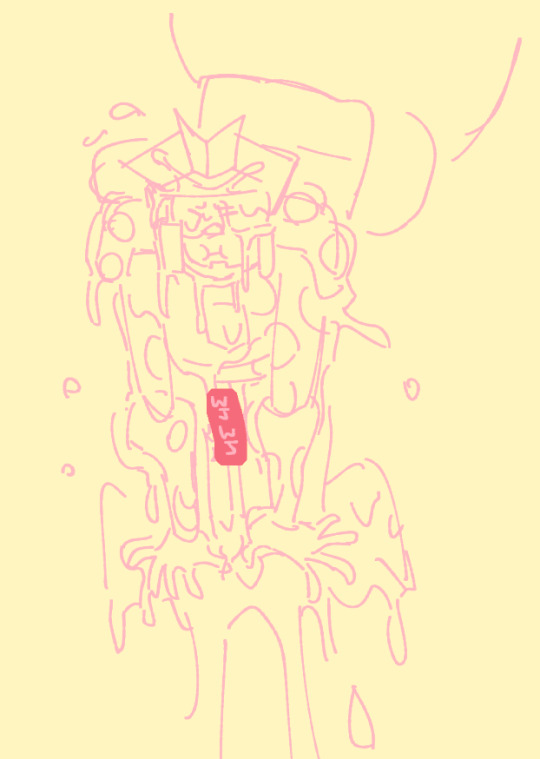
(he got a BOANER from getting FROTTED by DECEPTICONS. his ass is NOT surviving the traitor allegations)
#archie answers#transformers#my art#my requests#valveplug#/nsft#/nsfw#size difference#micro macro#oc x canon#/bukkake#my ocs#tf oc#tfa#tf animated#meter#strika#lugnut#strinut#???#lugka#???????#strika/lugnut
200 notes
·
View notes
Text

miller where he belongs <3
232 notes
·
View notes
Text

Looks like some1 ate a few 2 many berries :3
(OC - Eve)
#fat belly#feedee belly#inflated belly#fatfur#fat piggy#fatfurry#fat anime#inflateme#micro blob#feedee girl#blueberry inflation#blueberry
164 notes
·
View notes
Text
Gayboy Micro

#Lesser Woolly Bat#bats of africa#bat of the day#daily bat#bat#bats#batposting#cute bats#cute animals#look at them go#So tiny#Gayboy micro
236 notes
·
View notes